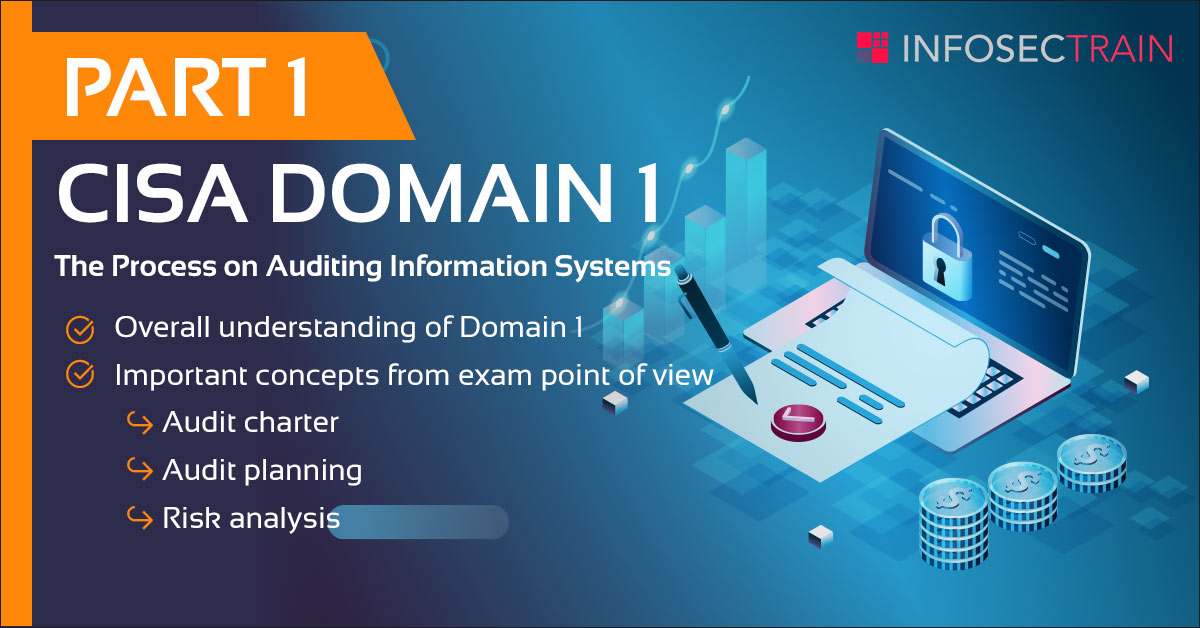CISA DOMAIN 1 (Part 1)- THE PROCESS ON AUDITING INFORMATION SYSTEMS
This article covers –
- Overall understanding of the domain
- Important concepts to focus on from exam point of view
The article is split into 3 parts as below:
- Part 1 – Overall understanding of Domain 1, Important concepts from exam point of view – Audit charter, Audit planning, Risk analysis
- Part 2 – Internal controls, COBIT – 5, Risk-based auditing, Risk treatment
- Part 3 – Compliance testing Vs. Substantive testing, Audit evidence, Audit Sampling and Control self-assessment

|
PART 1 |
Overall understanding of the domain:
Weightage – This domain constitutes 21 percent of the CISA exam (approximately 32 questions)
Covers 11 Knowledge statements covering the process of auditing information systems
- ISACA IS Audit and Assurance Standards, Guidelines, and Tools and Techniques, Code of Professional Ethics and other applicable standards
- risk assessment concepts and tools and techniques in planning, examination, reporting and follow-up
- Fundamental business processes and the role of IS in these processes
- Control principles related to controls in information systems
- Risk-based audit planning and audit project management techniques
- Applicable laws and regulations which affect the scope, evidence collection and preservation and frequency of audits
- Evidence collection techniques used to gather, protect and preserve audit evidence
- Different sampling methodologies and other substantive/data analytical procedures
- Reporting and communication techniques
- Audit quality assurance (QA) systems and frameworks
- Various types of audits and methods for assessing and placing reliance on the work of other auditors or control entities
Important concepts from exam point of view:
|
1.Audit Charter: |
- Audit Charter outlines the overall authority, scope and responsibilities of audit function
- Audit charter should be approved by Audit committee or senior management
- Internal audit function is always independent of management committee
Points to remember:
|
|
2.Audit planning: |
- Step 1 – Understanding of business mission, vision, objectives, process which includes information requirements under CIA trait (Confidentiality, Integrity and Availability of data)
- Step 2 – Understanding of business environment
- Step 3 – Review prior work papers
- Step 4 – Perform Risk analysis
- Step 5 – Set audit scope and objectives
- Step 6 – Develop audit plan/strategy
- Step 7 – Assign audit personal/resources
| Point to remember: The first step in the audit planning is always understanding the business mission, objectives and business environment, then analyzing the risk involved based in the audit scope. |
Audit planning includes –
- Short term planning – considers audit issues that will be covered during the year
- Long term planning – audit plans that will take into account risk-related issues regarding changes in the organization’s IT strategic direction that will affect the organization’s IT environment.
|
3.Risk analysis: |
- Risk is a combination of the probability of an event and its consequence (International Organization for Standardization [ISO] 31000:2009)
- Risk analysis is part of audit planning, and help identify risk and vulnerabilities so the IS auditor can determine the controls needed to mitigate those risk
| Point to remember: CISA candidate should be able to differentiate between threat and vulnerability. Threat is anything that can exploit a vulnerability, intentionally or accidentally, and obtain, damage, or destroy an asset. Vulnerability is Weakness or gap in a security program that can be exploited by threats to gain unauthorized access to an asset |
- Risk analysis covers Risk Management Framework – ISO 27005, ISO 31000
- Risk Assessment Process – The process starts with identifying the sources and events, then identifying the vulnerabilities associated with the sources, and then analyzing the probability of the occurrence and the impact.
- Risk Management Process – It begins with identifying the business objectives, the information assets that are associated with business, assessment of risk, how to mitigate the risk (either to avoid or transfer or mitigate/reduce the risk) and implementing controls to mitigate the risk)
Point to remember:
|






 1800-843-7890 (India)
1800-843-7890 (India)